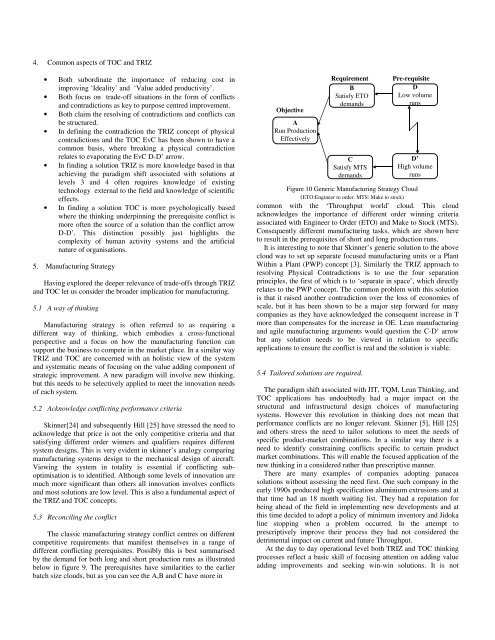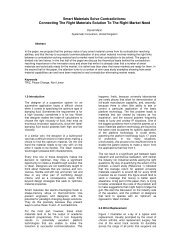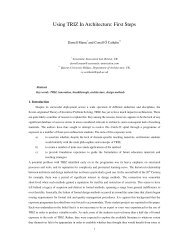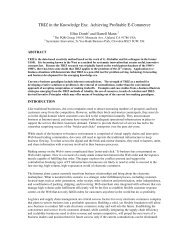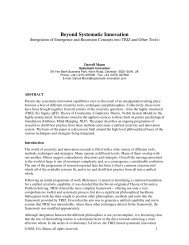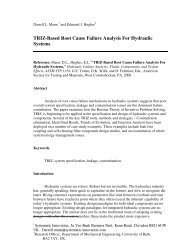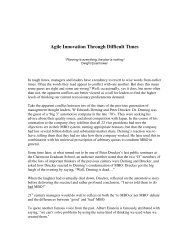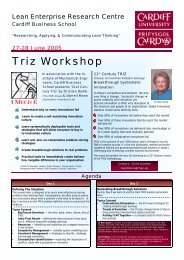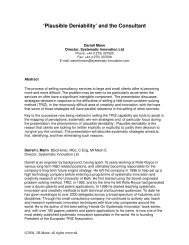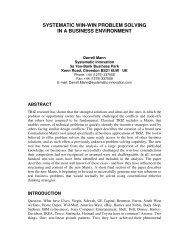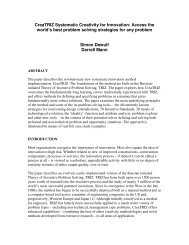From trade-offs to innovation - the underlying principles of TRIZ and ...
From trade-offs to innovation - the underlying principles of TRIZ and ...
From trade-offs to innovation - the underlying principles of TRIZ and ...
Create successful ePaper yourself
Turn your PDF publications into a flip-book with our unique Google optimized e-Paper software.
4. Common aspects <strong>of</strong> TOC <strong>and</strong> <strong>TRIZ</strong><br />
• Both subordinate <strong>the</strong> importance <strong>of</strong> reducing cost in<br />
improving ‘Ideality’ <strong>and</strong> ‘Value added productivity’.<br />
• Both focus on <strong>trade</strong>-<strong>of</strong>f situations in <strong>the</strong> form <strong>of</strong> conflicts<br />
<strong>and</strong> contradictions as key <strong>to</strong> purpose centred improvement.<br />
• Both claim <strong>the</strong> resolving <strong>of</strong> contradictions <strong>and</strong> conflicts can<br />
be structured.<br />
• In defining <strong>the</strong> contradiction <strong>the</strong> <strong>TRIZ</strong> concept <strong>of</strong> physical<br />
contradictions <strong>and</strong> <strong>the</strong> TOC EvC has been shown <strong>to</strong> have a<br />
common basis, where breaking a physical contradiction<br />
relates <strong>to</strong> evaporating <strong>the</strong> EvC D-D’ arrow.<br />
• In finding a solution <strong>TRIZ</strong> is more knowledge based in that<br />
achieving <strong>the</strong> paradigm shift associated with solutions at<br />
levels 3 <strong>and</strong> 4 <strong>of</strong>ten requires knowledge <strong>of</strong> existing<br />
technology external <strong>to</strong> <strong>the</strong> field <strong>and</strong> knowledge <strong>of</strong> scientific<br />
effects.<br />
• In finding a solution TOC is more psychologically based<br />
where <strong>the</strong> thinking underpinning <strong>the</strong> prerequisite conflict is<br />
more <strong>of</strong>ten <strong>the</strong> source <strong>of</strong> a solution than <strong>the</strong> conflict arrow<br />
D-D’. This distinction possibly just highlights <strong>the</strong><br />
complexity <strong>of</strong> human activity systems <strong>and</strong> <strong>the</strong> artificial<br />
nature <strong>of</strong> organisations.<br />
5. Manufacturing Strategy<br />
Having explored <strong>the</strong> deeper relevance <strong>of</strong> <strong>trade</strong>-<strong><strong>of</strong>fs</strong> through <strong>TRIZ</strong><br />
<strong>and</strong> TOC let us consider <strong>the</strong> broader implication for manufacturing.<br />
5.1 A way <strong>of</strong> thinking<br />
Manufacturing strategy is <strong>of</strong>ten referred <strong>to</strong> as requiring a<br />
different way <strong>of</strong> thinking, which embodies a cross-functional<br />
perspective <strong>and</strong> a focus on how <strong>the</strong> manufacturing function can<br />
support <strong>the</strong> business <strong>to</strong> compete in <strong>the</strong> market place. In a similar way<br />
<strong>TRIZ</strong> <strong>and</strong> TOC are concerned with an holistic view <strong>of</strong> <strong>the</strong> system<br />
<strong>and</strong> systematic means <strong>of</strong> focusing on <strong>the</strong> value adding component <strong>of</strong><br />
strategic improvement. A new paradigm will involve new thinking,<br />
but this needs <strong>to</strong> be selectively applied <strong>to</strong> meet <strong>the</strong> <strong>innovation</strong> needs<br />
<strong>of</strong> each system.<br />
5.2 Acknowledge conflicting performance criteria<br />
Skinner[24] <strong>and</strong> subsequently Hill [25] have stressed <strong>the</strong> need <strong>to</strong><br />
acknowledge that price is not <strong>the</strong> only competitive criteria <strong>and</strong> that<br />
satisfying different order winners <strong>and</strong> qualifiers requires different<br />
system designs. This is very evident in skinner’s analogy comparing<br />
manufacturing systems design <strong>to</strong> <strong>the</strong> mechanical design <strong>of</strong> aircraft.<br />
Viewing <strong>the</strong> system in <strong>to</strong>tality is essential if conflicting suboptimisation<br />
is <strong>to</strong> identified. Although some levels <strong>of</strong> <strong>innovation</strong> are<br />
much more significant than o<strong>the</strong>rs all <strong>innovation</strong> involves conflicts<br />
<strong>and</strong> most solutions are low level. This is also a fundamental aspect <strong>of</strong><br />
<strong>the</strong> <strong>TRIZ</strong> <strong>and</strong> TOC concepts.<br />
5.3 Reconciling <strong>the</strong> conflict<br />
The classic manufacturing strategy conflict centres on different<br />
competitive requirements that manifest <strong>the</strong>mselves in a range <strong>of</strong><br />
different conflicting prerequisites. Possibly this is best summarised<br />
by <strong>the</strong> dem<strong>and</strong> for both long <strong>and</strong> short production runs as illustrated<br />
below in figure 9. The prerequisites have similarities <strong>to</strong> <strong>the</strong> earlier<br />
batch size clouds, but as you can see <strong>the</strong> A,B <strong>and</strong> C have more in<br />
Objective<br />
A<br />
Run Production<br />
Effectively<br />
Requirement<br />
B<br />
Satisfy ETO<br />
dem<strong>and</strong>s<br />
C<br />
Satisfy MTS<br />
dem<strong>and</strong>s<br />
Figure 10 Generic Manufacturing Strategy Cloud<br />
(ETO:Engineer <strong>to</strong> order. MTS: Make <strong>to</strong> s<strong>to</strong>ck)<br />
common with <strong>the</strong> ‘Throughput world’ cloud. This cloud<br />
acknowledges <strong>the</strong> importance <strong>of</strong> different order winning criteria<br />
associated with Engineer <strong>to</strong> Order (ETO) <strong>and</strong> Make <strong>to</strong> S<strong>to</strong>ck (MTS).<br />
Consequently different manufacturing tasks, which are shown here<br />
<strong>to</strong> result in <strong>the</strong> prerequisites <strong>of</strong> short <strong>and</strong> long production runs.<br />
It is interesting <strong>to</strong> note that Skinner’s generic solution <strong>to</strong> <strong>the</strong> above<br />
cloud was <strong>to</strong> set up separate focused manufacturing units or a Plant<br />
Within a Plant (PWP) concept [3]. Similarly <strong>the</strong> <strong>TRIZ</strong> approach <strong>to</strong><br />
resolving Physical Contradictions is <strong>to</strong> use <strong>the</strong> four separation<br />
<strong>principles</strong>, <strong>the</strong> first <strong>of</strong> which is <strong>to</strong> ‘separate in space’, which directly<br />
relates <strong>to</strong> <strong>the</strong> PWP concept. The common problem with this solution<br />
is that it raised ano<strong>the</strong>r contradiction over <strong>the</strong> loss <strong>of</strong> economies <strong>of</strong><br />
scale, but it has been shown <strong>to</strong> be a major step forward for many<br />
companies as <strong>the</strong>y have acknowledged <strong>the</strong> consequent increase in T<br />
more than compensates for <strong>the</strong> increase in OE. Lean manufacturing<br />
<strong>and</strong> agile manufacturing arguments would question <strong>the</strong> C-D’ arrow<br />
but any solution needs <strong>to</strong> be viewed in relation <strong>to</strong> specific<br />
applications <strong>to</strong> ensure <strong>the</strong> conflict is real <strong>and</strong> <strong>the</strong> solution is viable.<br />
5.4 Tailored solutions are required.<br />
Pre-requisite<br />
D<br />
Low volume<br />
runs<br />
D’<br />
High volume<br />
runs<br />
The paradigm shift associated with JIT, TQM, Lean Thinking, <strong>and</strong><br />
TOC applications has undoubtedly had a major impact on <strong>the</strong><br />
structural <strong>and</strong> infrastructural design choices <strong>of</strong> manufacturing<br />
systems. However this revolution in thinking does not mean that<br />
performance conflicts are no longer relevant. Skinner [5], Hill [25]<br />
<strong>and</strong> o<strong>the</strong>rs stress <strong>the</strong> need <strong>to</strong> tailor solutions <strong>to</strong> meet <strong>the</strong> needs <strong>of</strong><br />
specific product-market combinations. In a similar way <strong>the</strong>re is a<br />
need <strong>to</strong> identify constraining conflicts specific <strong>to</strong> certain product<br />
market combinations. This will enable <strong>the</strong> focused application <strong>of</strong> <strong>the</strong><br />
new thinking in a considered ra<strong>the</strong>r than prescriptive manner.<br />
There are many examples <strong>of</strong> companies adopting panacea<br />
solutions without assessing <strong>the</strong> need first. One such company in <strong>the</strong><br />
early 1990s produced high specification aluminium extrusions <strong>and</strong> at<br />
that time had an 18 month waiting list. They had a reputation for<br />
being ahead <strong>of</strong> <strong>the</strong> field in implementing new developments <strong>and</strong> at<br />
this time decided <strong>to</strong> adopt a policy <strong>of</strong> minimum inven<strong>to</strong>ry <strong>and</strong> Jidoka<br />
line s<strong>to</strong>pping when a problem occurred. In <strong>the</strong> attempt <strong>to</strong><br />
prescriptively improve <strong>the</strong>ir process <strong>the</strong>y had not considered <strong>the</strong><br />
detrimental impact on current <strong>and</strong> future Throughput.<br />
At <strong>the</strong> day <strong>to</strong> day operational level both <strong>TRIZ</strong> <strong>and</strong> TOC thinking<br />
processes reflect a basic skill <strong>of</strong> focusing attention on adding value<br />
adding improvements <strong>and</strong> seeking win-win solutions. It is not


